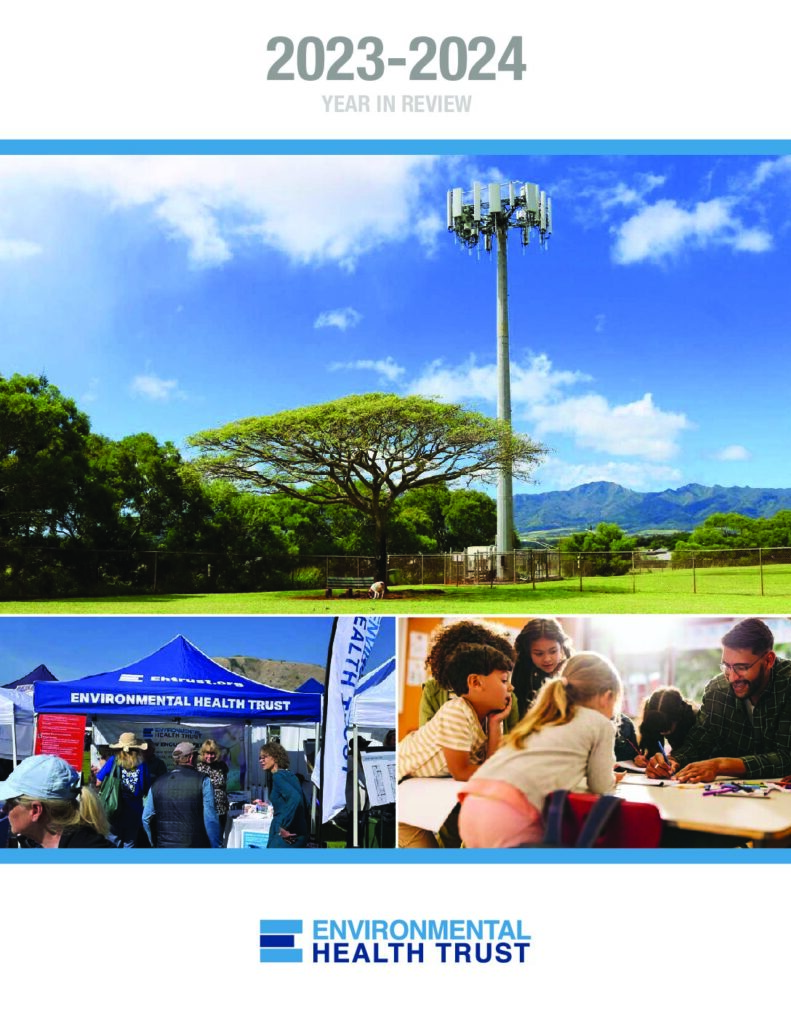Climate Change, 5G and the Internet of Things
Download and share our Factsheet on 5G, Energy Consumption and Climate Change here. This fact sheet is hyperlinked to research studies and is a great resource to raise awareness.
The unbridled energy consumption of our wireless revolution, 4G, 5G and the Internet of things is contributing to climate change. 5G requires millions of new cellular antennas called “small cells” -basically shorter cell towers- to be built in neighborhoods directly in front of our homes. These 5G antennas are to connect with billions of new wirelessly connected “smart” devices referred to as the Internet of Things (IOT). Massive Increases in 5G Equipment = Massive Increases in Energy Use

Click here to download EHT’s 5G and Climate Change Factsheet.
Researchers are warning us that the energy consumption of 5G and the IOT is growing and projected to skyrocket. 5G is NOT Sustainable The demand for technology is outstripping the increase in efficiency. Energy consumption will rise sharply due to the ever-increasing IOT energy demands at every stage of the lifecycle of 5G equipment, from device manufacture to data centers to data transmissions, and networks.
- 70.2 million “small cell” tower bases to be installed by 2025.
- 500 billion devices are expected to be connected to the Internet by 2030.
- 8.9 billion mobile phone subscriptions worldwide by 2024.
- 60% growth a year in the production of wireless peripherals (Wi-Fi/ Bluetooth speakers, appliances, wearables).
- 7-fold increase in mobile data traffic globally is projected between 2017 and 2022.
In economics, the Jevons Paradox is when technological progress increases the efficiency with which a resource is used, however demand and consumption increase as well. Thus- the end result is the overall increased use of the resource, despite efficiency gains.
5G is an Energy Hog “A lurking threat behind the promise of 5G delivering up to 1,000 times as much data as today’s networks is that 5G could also consume up to 1,000 times as much energy.” -IEEE Spectrum, 5G’s Waveform Is a Battery Vampire
We Must Consider the Environmental Footprint of the Digital Ecosystem. “Behind each byte we have mining and metal processing, oil extraction and petrochemicals, manufacturing and intermediate transports, public works (to bury the cables) and power generation with coal and gas. As a result, the carbon footprint of the global digital system is already 4% of the global greenhouse gas emissions, and it’s energy consumption rises by 9% per year.” – Jean-Marc Jancovici, President of The Shift Project, member of the French High Climate Council
5G Harms Bees, Trees and Birds “The electromagnetic radiation standards used by the Federal Communications Commission (FCC) continue to be based on thermal heating, a criterion now nearly 30 years out of date and inapplicable today.” -The Department of Interior in a 2014 letter on the impact of cell towers on migratory birds.
- Research finds bees and pollinators absorb the higher frequencies of 5G between 3% to 370% higher leading the scientists to warn, “This could lead to changes in insect behaviour, physiology, and morphology over time….”
- Research finds wireless frequencies interfere with birds’ navigation systems, and their circadian rhythms, and can harm their development and reproduction.
- Research finds trees can be harmed by the radiation from cellular antennas. Effects include altered growth, thinner cell walls and adverse biochemical changes.
EHT has a compendium of research on impacts to trees, bees and birds here.
Damage to the Tree Canopy Trees play a vital role in mitigating climate change, sequestering millions of tons of carbon that would otherwise pollute our climate. The installation of 5G equipment often requires heavy pruning and digging. This will clearly impact the canopy and root system of our trees. Read the Sierra Clubs testimony to Washington DC about the impact to trees from the 5G small cell deployment.
All things wireless is NOT the answer. “Wireless devices, antenna networks, and data centers are consuming an ever-increasing portion of the global energy supply, based largely on coal…” -“Re-Inventing Wires: The Future of Landlines and Networks” According to the Centre for Energy Efficient Telecommunications;
- “Our energy calculations show that by 2015, wireless cloud will consume up to 43 TWh, compared to only 9.2 TWh in 2012, an increase of 460%. This is an increase in carbon footprint from 6 megatonnes of CO2 in 2012 to up to 30 megatonnes of CO2 in 2015, the equivalent of adding 4.9 million cars to the roads. Up to 90% of this consumption is attributable to wireless access network technologies, data centres account for only 9%…”
- “…wireless access networks are clearly the biggest and most inefficient consumer of energy in the cloud environment.” Solutions for Fast, Safe and Secure Internet Connections Do Exist.
A national wireline system can guarantee for everyone a superior foundation of Internet access, unequaled connectivity speed, safety, privacy, security, energy efficiency, and long-term sustainability.
Wireless devices use energy even when you are not using them- in standby mode.
The most significant factor driving the increase in network standby-related energy use of connected devices is the increasing number of connected devices. Some of the key products that appear to be increasing global network standby energy use are:
- Voice assistant speakers
- Wi-Fi-connected IoT devices and other Wi-Fi-connected appliances
- Media devices, such as STBs and OTT media players
Download and share our Factsheet on 5G, Energy Consumption and Climate Change here. This fact sheet is hyperlinked to research studies and a great resource to raise awareness.
Referenced Reports Note: More studies on impacts to wildlife here. MTN Consulting, Operators facing power cost crunch, March 27, 2020 Fierce Wireless “5G base stations use a lot more energy than 4G base stations: MTN” April 3, 2020 Engels, Svenja, et al. “Anthropogenic electromagnetic noise disrupts magnetic compass orientation in a migratory bird.” Nature, 2014 Thielens et al., “Exposure of Insects to Radio-Frequency Electromagnetic Fields from 2 to 120 GHz” Scientific Reports, 2018 Waldmann-Selsam, C., et al. “Radiofrequency radiation injures trees around mobile phone base stations.” Science of the Total Environment, 2016 The Shift Project, “Lean ICT: Towards Digital Sobriety: Report on the Environmental Impact of Information and Communication Technologies, February 2019
- This comprehensive report by a think tank advocating the shift to a post-carbon economy documents the increased power consumption of the IOT and recommends solutions.
Andrae & Edler of Huawei Technologies, On Global Electricity Usage of Communication Technology: Trends to 2030 Challenges 2015
- Estimates and analyses of the global electricity usage that can be ascribed to Communication Technology (CT) between 2010 and 2030. For the worst-case scenario, CT electricity usage could contribute up to 23% of the globally released greenhouse gas emissions in 2030.
Vertiv, Telco Industry Hopes and Fears FROM ENERGY COSTS TO EDGE COMPUTING TRANSFORMATION, 2019
- “5G is widely expected to raise overall energy costs,” based on Vertiv’s industry analysis.
Timothy Schoechle, “Re-Inventing Wires: The Future of Landlines and Networks,” National Institute for Science, Law & Public Policy, May 2018
- “ Wireless networks and services, compared to wired access, are inherently more complex, more costly, more unstable (subject to frequent revision and “upgrades”), and more constrained in what they can deliver.”
Baliga et al. of the University of Melbourne, Energy Consumption in Wired and Wireless Access Networks, IEEE Communications, June 2011
- The energy consumption of the “wireless cloud” can exceed the energy consumption of data centres by 10X.
Morley et al., Lancaster University, “Digitalisation, energy and data demand: The impact of Internet traffic on overall and peak electricity consumption” Energy Research and Social Science, 2018
- “We argue that policies and interventions in this area should aim to do more than improve the energy efficiency of digital infrastructures: they can also focus on the growing demand for data.”
- Mobile networks are more electricity intensive than fixed-line access networks yet mobile data traffic is growing faster.”
The Center for Energy Efficient Telecommunications at the University of Melbourne “The Power of Wireless Cloud”, 2013
- This study found that wireless networking infrastructure worldwide accounts for significantly more power consumption than data centers.
Shehabi et al., “United States Data Center Energy Usage Report” Berkeley Laboratory, 2016
- Based on current trend estimates, U.S. data centers are projected to consume approximately 73 billion kWh in 2020.







